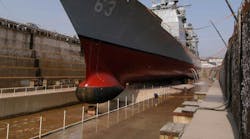By John McHale
ORLANDO, Fla. — Experts at the Asset Group of Science Applications International Corp. (SAIC) have developed a combat infantry simulator that helps soldiers learn to fight at close quarters on streets and in buildings of densely populated cities.
The urban simulation enables soldiers to train in small squads of four to nine members in a city environment, says Matt Kraus, program manager for human simulation at SAIC's Asset Group.
SAIC engineers have mapped entire buildings and the cities in which they lie, not only for military training but also for law enforcement, city management, and building design, Kraus says.
SAIC officials say they intend technology to improve building security, traffic control, disaster relief, and of course military readiness.
It is a sophisticated computer version of the old police obstacle course — where a police officer in training goes though a cardboard town shooting at cardboard cutouts of criminal suspects and trying not to shoot innocent bystanders, Kraus says. The long-term goal of the simulation would be akin to replicating the holodeck on the Star Trek television show.
Army leaders developed this simulation to help foot soldiers train on the virtual battlefield in a realistic fashion. Before, the infantry capabilities of simulations were limited to a difficult-to-see anti-tank threat, Kraus says.
The urban simulation uses commercial-off-the-shelf hardware (COTS) and what Krause calls "government-off-the-shelf" software. The software is constantly being tweaked so it cannot truly be called COTS, he adds.
In the first phase of the project, the urban simulation was developed from a Marine Corps variant that supported individual combat units in open terrain. For the next phase, experts added restricted terrain to test military operations in urban terrain simulation capabilities.
The urban experiments took place on a simulated urban terrain database that represented the McKenna urban site at Fort Benning, Ga. Technicians created a scenario where fire teams blew a hole in a building, entered the building through the hole, cleared rooms, and fought the enemy inside, SAIC officials say.
The goal was to investigate how well the urban simulation could support urban warfare at the individual soldier, fire team, squad, and platoon levels. Experiments focused on basic tasks supporting individual and, to a lesser extent, collective task performance, SAIC officials explain.
A four-man fire team can practice the tactics necessary to clear one room, while a nine-man squad demonstrates the tactics of clearing several different rooms.
Other scenarios simulate a nine-man squad as it lays down suppressive fire; a nine-man squad as it encounters covered and/or concealed positions along the battle position; and two-man scenarios of specialized tactics that involve using different weapons.
The soldiers suspended their disbelief and became totally immersed in the simulation, SAIC officials claim. However, technical improvements are still necessary in weapon aiming and in visual scene detail, Kraus adds. Army officials need precise aiming to accurately tally kill statistics, he explains.
Technicians also need to improve the simulation's artificial intelligence algorithms to enable computer-generated forces to act autonomously, he says. One need is to clearly depict the different sounds of the AK-47 and M-16 combat infantry rifles, Kraus explains.
Another possible area of improvement involves lighting, Kraus notes. Currently the simulations only operate in a fully lighted environment, he says. The next step will be adding night-vision capabilities to the simulator, Krause adds.
The primary focus of the urban simulation has been the development of tactical behaviors for dismounted infantry operations, SAIC officials say. Yet, providing a sufficient number of simulators for such an experiment is too expensive, Kraus says. Instead the use of computer-generated soldiers is cost effective and provides a means to model large numbers of enemy and friendly forces, he adds.
Currently the simulators can support 10,000 entities operating at the same time, Kraus says. Different live users can join the simulation via modem from anywhere in the world, which is similar to video games where players from different locations play in real-time over the Internet, he explains.
Development has built on existing virtual simulation systems, which have been integrated into an interoperable network of individual soldier simulators and simulations.
Near-term development work includes: terrain analysis for improved movement planning using cover and concealment, new weapons models for hand grenades and the M203 grenade launcher, open terrain behavior upgrades, aural sensing, and integration into the OneSAF test bed.
Longer-term development work calls for inclusion of Land Warrior Weapon, visual sensing, improving SAF situation awareness, and intelligent target selection, SAIC officials say.
The modifications to previous systems that were made for urban simulation include: individual combatant entity type definition, DIS definitions, body definitions, physical database modifications, physical movement, and collision models.



